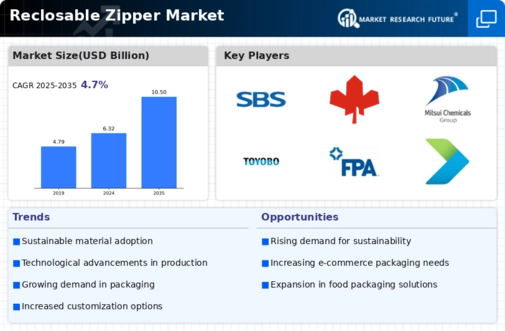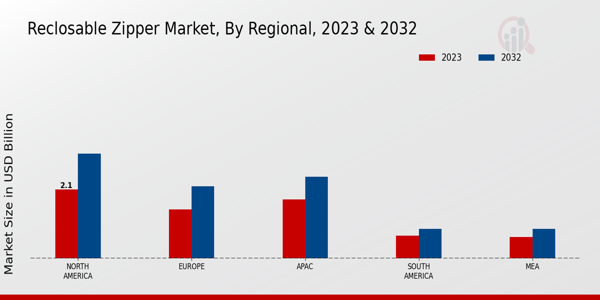Market Growth Projections
The Global Reclosable Zipper Market Industry is poised for substantial growth, with projections indicating a market value of 6.32 USD Billion in 2024 and an anticipated increase to 10.5 USD Billion by 2035. This growth trajectory suggests a compound annual growth rate of 4.69% from 2025 to 2035. Such figures reflect the increasing adoption of reclosable zippers across various sectors, driven by consumer demand for convenience and sustainability. The market's expansion is likely to be supported by ongoing innovations and the rising importance of efficient packaging solutions in a rapidly evolving global landscape.
Growth in E-commerce and Online Retail
The Global Reclosable Zipper Market Industry is significantly influenced by the expansion of e-commerce and online retail. As more consumers turn to online shopping, the need for efficient and secure packaging solutions has surged. Reclosable zippers provide convenience and protection for products during transit, making them an attractive choice for e-commerce businesses. The market is projected to reach 6.32 USD Billion in 2024, reflecting the increasing reliance on reclosable zippers in packaging for various products sold online. This trend indicates a robust growth trajectory, as e-commerce continues to reshape consumer purchasing behaviors.
Emerging Markets and Regional Expansion
The Global Reclosable Zipper Market Industry is benefiting from emerging markets and regional expansion. Countries in Asia-Pacific and Latin America are witnessing a surge in demand for reclosable zippers, driven by urbanization and rising disposable incomes. As these regions develop, the need for efficient packaging solutions in various sectors, including food, cosmetics, and pharmaceuticals, is increasing. This growth potential is reflected in the market's projected increase to 10.5 USD Billion by 2035. Companies are likely to focus on these emerging markets to capitalize on the growing consumer base and evolving packaging needs.
Increasing Applications in Food Packaging
The Global Reclosable Zipper Market Industry is experiencing growth due to the increasing applications of reclosable zippers in food packaging. As food safety and preservation become paramount, manufacturers are leveraging zippers to create airtight seals that extend product shelf life. This trend is particularly evident in snack packaging, where reclosable zippers allow consumers to reseal packages after opening, maintaining freshness. The industry's adaptation to these needs is likely to drive market expansion, as food manufacturers seek reliable packaging solutions that enhance product quality and consumer satisfaction.
Innovations in Product Design and Functionality
Innovations in product design and functionality are propelling the Global Reclosable Zipper Market Industry forward. Manufacturers are investing in research and development to create zippers that offer enhanced usability, such as easy-open features and improved sealing capabilities. These innovations cater to diverse applications, from food packaging to medical supplies, thereby broadening the market's reach. As the industry evolves, the introduction of advanced materials and designs is expected to attract new customers and retain existing ones. This focus on innovation is likely to contribute to a compound annual growth rate of 4.69% from 2025 to 2035.
Rising Demand for Sustainable Packaging Solutions
The Global Reclosable Zipper Market Industry is witnessing a notable shift towards sustainable packaging solutions. As consumers increasingly prioritize eco-friendly products, manufacturers are adapting by incorporating biodegradable materials into their reclosable zipper designs. This trend is not only driven by consumer preferences but also by regulatory pressures aimed at reducing plastic waste. For instance, brands are now using reclosable zippers made from recycled materials, which aligns with global sustainability goals. The industry's response to this demand is likely to enhance market growth, as sustainable practices become integral to packaging strategies.











